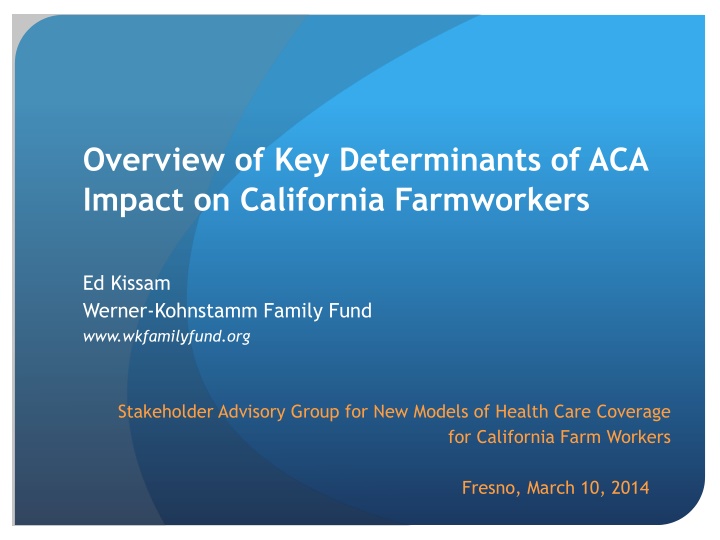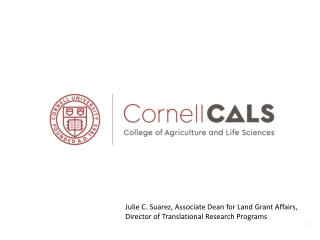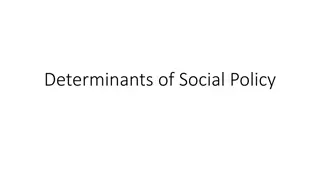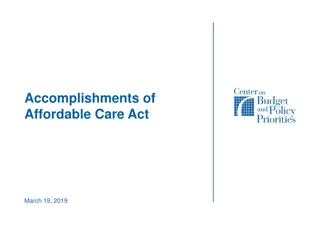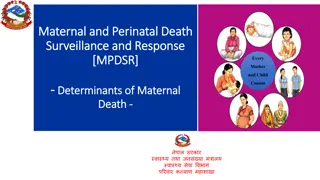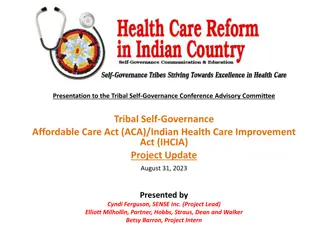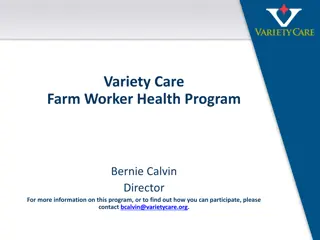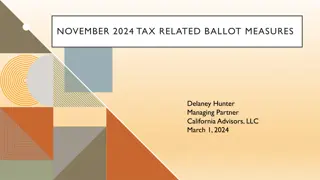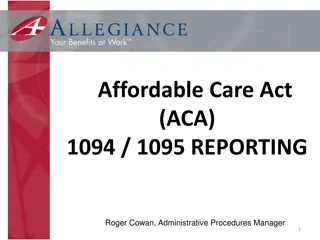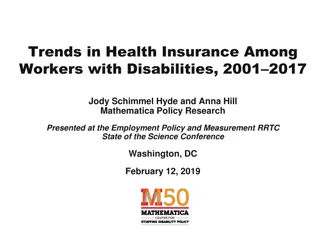Overview of Key Determinants of ACA Impact on California Farmworkers
ACA provisions offer subsidized health insurance with limitations for California farmworkers based on legal status and employer coverage. Disparities in coverage among sub-populations are evident, highlighting challenges faced by seasonal, female, and newly arrived farmworkers. Exclusions from the ACA employer mandate further impact access to health insurance for certain farmworkers.
Uploaded on Feb 20, 2025 | 0 Views
Download Presentation

Please find below an Image/Link to download the presentation.
The content on the website is provided AS IS for your information and personal use only. It may not be sold, licensed, or shared on other websites without obtaining consent from the author.If you encounter any issues during the download, it is possible that the publisher has removed the file from their server.
You are allowed to download the files provided on this website for personal or commercial use, subject to the condition that they are used lawfully. All files are the property of their respective owners.
The content on the website is provided AS IS for your information and personal use only. It may not be sold, licensed, or shared on other websites without obtaining consent from the author.
E N D
Presentation Transcript
Overview of Key Determinants of ACA Impact on California Farmworkers Ed Kissam Werner-Kohnstamm Family Fund www.wkfamilyfund.org Stakeholder Advisory Group for New Models of Health Care Coverage for California Farm Workers Fresno, March 10, 2014
ACA Provisions for Subsidized Insurance: Great Potential, Limited Practical Impact Based on family income, almost all (at least 85%) of FW families would qualify for subsidized health insurance. More than half (58%) would qualify for Medicaid. But farmworkers without legal status cannot receive subsidies or qualify for Medicaid (except for a limited sub-set of services). About two-thirds (67%) of California farmworkers lack legal status. Unfortunately, the sub-populations of FW s who ACA grants access are those who need it less because their employers already offer them insurance and those who most need access are those who are denied access due to legal status
FWs current coverage by Immigration Status and HH Income Farmworkers Who Currently Have Health Insurance Not authorized Authorized 54% 52% 52% 44% 23% 18% 14% 12% < 100% Poverty 100% to <133% Poverty 133% to < 200% poverty > 200% poverty
Notable disparities in FW sub-populations currently covered by insurance paid for by their employers FW s without legal status Only about 11% have employer-paid health insurance Seasonal workers--Only 7% of seasonal workers with <150 days of FW per year have employer-paid health insurance Female seasonal workers-Only 6% of the female seasonal workers with <150 days of FW per year have employer- paid health insurance Newly-arrived Only 6% of newly-arrived (<3 yrs. in US) foreign-born FW s currently have employer-provided insurance coverage. Disproportionate numbers of indigenous migrantes
Exclusions from the ACA employer mandate based on employer size In 2015, only employers with 100+ FTE workers need to offer their workers insurance. In 2016, employers with 50+ FTE workers must offer insurance. But, apparently, as of March 5, do not need to be ACA-compliant . With labor costs amounting to 40-50% of total labor-intensive farm production costs and with a FTE farmworker costing about $23,000/yr. small farms are those with less than $2.4 million in annual sales and medium-size farms are those with $2.4-4.8 million. So, in 2015, only 20-30% of Pacific Seaboard workers will work for an employer who needs to offer them insurance. In 2016, about half will. But the FW s whose employers need to offer them insurance are probably those who already offer it usually to their core labor force.
Exclusion of most seasonal FWs? February 12thfinal IRS regulations likely allow exclusion of many FW s who work 195 days or less for an employer as part time from the mandate. This means that at least half (~48%) of FW s may not need to be offered insurance because they are seasonal. The complexity of the IRS regulations re employer options for measurement period , treatment of new vs. current employees makes for uncertainties about exactly how many FW s will be deemed part-time in 2015. And it s even murkier in 2016. Some experts believe that when employer policies are renewed, insurers may require that at least 70% of the employer s workforce be covered to issue a policy. This may induce some employers to be more generous in deciding which seasonal workers are part-time or full time . However, it is uncertain if this helps since the seasonal workers, by and large, are also the poorest and may be unable to accept the offer
Uncertainties in Estimates of ACA Impact: Overlap of FW sub-groups vis- -vis access Workers at small or medium employer Seasonal Workers Unauthorized workers NAWS provides reliable estimates of overlap between seasonal workers and legal status, as well as income, family size, and demographic characteristics But USDA/ERS farm taxonomy makes estimation of the overall proportion of workers working for small or medium size employers as defined by ACA challenging. USDA data is not linked to NAWS and has no detail on demographics, legal status, worker earnings, FW household composition
Different Pathways for Access to Health Care: Most of them Problematic, Some Blocked Via mandate and subsidized when out of work Only via mandate. not when out of work Only access to subsidized coverage or Medicaid No ACA access at all limited to medically indigent Employer= not- big Status=not legal OR Employer= big Status= not legal FW=seasonal Employer=big Status=legal FW=semi- seasonal or non-seasonal Employer=big Status=not legal FW= semi- seasonal or non-seasonal OR spouse works has insurance from work (indirect) Employer=not-big Status=legal Income= low or medium OR Employer= big Status=legal FW=seasonal Income= low or medium Mostly older, more full-time, legal FW s, few women Income-sensitive and intermittent, problems for semi- seasonal Skews toward legal and low-income. bi-modal distribution-- very young, middle-aged Undocumented working for small employer or seasonally for large
Estimated 2015 Distribution of FW Access via ACA ( small and medium employers excluded) Access within the overall farmworker population No option no access to subsidy or employer insurance 57% Via mandate-no access when seasonally unemployed 10% Via mandate-access to subsidy when unemployed 5% No mandated employer insurance but can access subsidies 28% No definite access spouse works, is covered by employer 2% *Model assumes 70% of FW s employed by small or medium-size_ employers (<100 FTE), that 48% are considered part-time due to seasonality, that 67% lack legal status and that the workforce of small, medium, and large agribusiness employers are similar in seasonality of employment and legal status to the overall FW population (actual distribution is unknown)
Estimated 2016 Distribution of FWs ACA Access (only small employers excluded) Access within the overall farmworker population No option no access to subsidy or employer insurance 46% Via mandate--no access when seasonally unemployed 21% Via mandate--access to subsidy when unemployed 12% No mandated employer insurance but can access subsidies 20% No definite access spouse works and is covered by employer 2% *Model assumes 40% of FW s are employed by small employers, that 48% of FW s are considered part-time due to seasonality, that 67% lack legal status and that the workforce of small, medium, and large agribusiness employers are similar in seasonality of employment and legal status to the overall FW population (actual distribution is unknown)
Policy and Practical Issues: Net Result of the Employer Mandate on FW Health Access? As a result of ACA rules, 15% of FW s in the Western U.S. might need to be offered a policy by their employer in 2015, about 33% in 2016 (at least for part of the year). The 17% who already get insurance from their employers are concentrated among the older demographic groups who are most steadily employed so it s unlikely the mandate improves numbers of FW s covered The NAWS data on the legal status of workers in different demographic groups suggests that these older FW s, more likely to have chronic health problems, will fall under the employer mandate and have access to Covered California or Medic-Cal However, my model estimating sub-groups of farmworkers which ACA rules impact in different ways highlights the overall problem of intermittent coverage, especially for the one-quarter or so of California farmworkers who work for more than one employer.
Policy and Practical Issues: Which sub- populations are left without any access? OverallMore than half (57%) of FW s are left totally out in the cold in 2015, and in 2016 slightly less than half (46%) are. Who are they? The more seasonally-employed and the undocumented The older FW s with legal status typically secure steadier work. Many are part of an employer s core labor force . Women with children Many work only seasonally or have more intermittent employment due to problems of child care, transportation. The employer mandate does not require spouses be covered. Aging post-IRCA long-term settlers who no longer are as competitive in the labor market as they once were and who arrived too late for amnesty Migrants, especially the recently-arrived younger FW s solo males but, also, young indigenous families. These vulnerable groups already have great difficulty navigating the system
Contact information Ed Kissam edkissam@me.com WKF Fund http://www.wkfamilyfund.org
